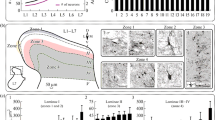Objective. To conduct a comparative analysis of subpopulations of interneurons containing calbindin (CAB), calretinin (CAR), and parvalbumin (PAV) in the dorsal horn of segments T3–T5 of the spinal cord (SC). Materials and methods. Immunoreactive (IR) interneurons were studied in female C57BL/6 mice aged 16 weeks using immunohistochemical methods. Results. All IR-interneuron subpopulations were topographically detected in all laminae of the dorsal horn of the SC, though PAV-IR interneurons were not detected in lamina I. The content of CAB interneurons dominated in laminae I (27%) and II (29%), CAR interneurons in lamina II (21.5%), and PAV interneurons in laminae IV (5.7%) and V (6.2%). In addition, the PAV interneuron subpopulation consisted of a smaller group of cells than those of the other calcium-binding proteins in laminae II and III and the medial border (MB) of the dorsal horn, while CAR interneurons were a smaller group in laminae III, IV, and V and the MB. Quantitatively, calbindin-containing interneuron subpopulations dominated in all laminae of the dorsal horn of the SC. Cell sizes in these subpopulations of IR interneurons were statistically significantly different – CAB- and CAR-containing interneurons being larger and PAV-containing cells being smaller. Conclusions. Different subpopulations of interneurons immunoreactive to calbindin, calretinin, and parvalbumin were found in the dorsal horn of the SC and were specific to each lamina.
Similar content being viewed by others
References
A. A. Andreev-Andrievskii, B. S. Shenkman, A. S. Popova, et al., “Experimental studies in mice in the ‘Bion-M1’ satellite program,” Aviakosm. Ekol. Med., 48, No. 1, 14–27 (2014).
V. V. Porseva, V. V. Shilkin, A. A. Strelkov, and P. M. Maslyukov, “Subpopulations of calbindin-immunoreactive interneurons in the dorsal horn of the spinal cord in mice,” Tsitologiya, 56, No. 8, 612– 618 (2014).
S. Chen, G. Yang, Y. Zhu, et al., “A comparative study of three interneuron types in the rat spinal cord,” PLoS One, 11, No. 9, e0162969, (2016), doi: https://doi.org/10.1371/journal.pone.0162969.
J. J. Kim, I. Y. Chang, Y. Y. Chung, et al., “Immunohistochemical studies on the calbindin D-28K and parvalbumin positive neurons in the brain stem and spinal cord after transection of spinal cord of rats,” Korean Phys. Anthropol., 15, No. 4, 305–329 (2002), doi: https://doi.org/10.11637/kjpa.2002.15.4.305.
A. J. Levine, C. A. Hinckley, K. L. Hilde, et al., “Identification of a cellular node for motor control pathways,” Nat. Neurosci., 17, No. 4, 586–593 (2014), doi: https://doi.org/10.1038/nn.3675.
Y. N. Li, Y. C. Li, H. Kuramoto, et al., “Immunohistochemical demonstration of the calcium channel alpha2 subunit in the chicken dorsal root ganglion and spinal cord: a special reference to colocalization with calbindin-D28k in dorsal root ganglion neurons,” Neurosci. Res., 59, No. 3, 304–308 (2007), doi: https://doi.org/10.1016/j.neures.2007.07.008.
N. Merkulyeva, A. Veshchitskii, F. Makarov, et al., “Distribution of 28 kDa calbindin-immunopositive neurons in the cat spinal cord,” Front. Neuroanat., 9, 166 (2016), doi: https://doi.org/10.3389/fnana.2015.00166 Correct version.
C. Molander, Q. Xu, C. Rivero-Melian, and G. Grant, “Cytoarchitectonic organization of the spinal cord in the rat: II. The cervical and upper thoracic cord,” J. Comp. Neurol., 289, No. 3, 375–385 (1989), doi: https://doi.org/10.1002/cne.902890303.
R. Morona, J. M. Lopez, and A. Gonzalez, “Calbindin-D28k and calretinin immunoreactivity in the spinal cord of the lizard Gekko gecko: Colocalization with choline acetyltransferase and nitric oxide synthase,” Brain Res. Bull., 69, No. 5, 519–534 (2006), doi: https://doi.org/10.1016/j.brainresbull.2006.02.022.
B. Schwaller, “The use of transgenic mouse models to reveal the functions of Ca2+ buffer proteins in excitable cells,” Biochim. Biophys. Acta, 1820, No. 8, 1294–1303 (2012), doi: https://doi.org/10.1016/j.bbagen.2011.11.008.
M. D. Zhang, G. Tortoriello, B. Hsueh, et al., “Neuronal calcium-binding proteins 1/2 localize to dorsal root ganglia and excitatory spinal neurons and are regulated by nerve injury,” Proc. Natl. Acad. Sci. USA, 111, No. 1, E1149–1158 (2014), doi: https://doi.org/10.1073/pnas.1402318111.
Author information
Authors and Affiliations
Corresponding author
Additional information
Translated from Morfologiya, Vol. 157, No. 1, pp, 18–23, January–February, 2020.
Rights and permissions
About this article
Cite this article
Porseva, V.V., Emanuilov, A.I. & Maslyukov, P.M. Subpopulations of Calbindin-, Calretinin-, and Parvalbumin-Immunoreactive Interneurons in the Dorsal Horn of the Spinal Cord in Female C57BL/6 Mice. Neurosci Behav Physi 50, 961–965 (2020). https://doi.org/10.1007/s11055-020-00991-2
Received:
Revised:
Published:
Issue Date:
DOI: https://doi.org/10.1007/s11055-020-00991-2



